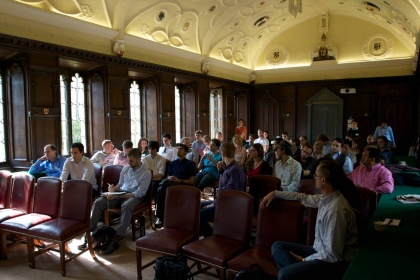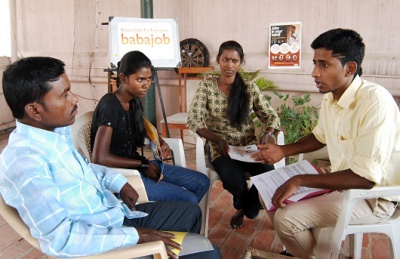Effective Altruism
Effective altruism, abbreviated EA, is a relatively new philosophical ideology and social movement centered around the question: how do we use evidence and reasoning to best improve the lives of others?[1] At the forefront of this movement is the philosopher Peter Singer. He theorizes that because we are able to do good, we are morally obligated to. [2] He goes further in this thinking and says that we can more effectively make a difference with our money by donating to international causes where smaller amounts of money can save more lives[3]. He argues that because of the technology we have these days, we can reach any corner of the world with the click of a button, making it easier to give back. A key focus of EA research is considering the counterfactual. [4]This means considering what would have happened in an area if a charitable intervention hadn't taken place. This helps to analyze the breadth of impact done by an organization. Effective altruism’s research and ease of use are mostly due to technology. Discussed is what effective altruists do, what an average person can do to participate, the history of the movement, digital altruism, and ethical concerns with this ideology.

Contents
What Effective Altruists Do
One of the main focuses of effective altruism is charity and non-profit impact research.[5] To make the biggest impact on others lives, one can donate money to a charity. All charities strive to make a difference, but some of them have a bigger impact than others. Effective altruists seek charities that are highly cost-effective and ones that are making progress towards their goals. This can be assessed through impact evaluations. Technological tools such as statistical software and algorithms allow groups to analyze the impact of their work. There are many organizations devoted to analyzing charity impacts, such as GiveWell and Good Ventures.
Effective Altruism Community
There is currently a global community available for EAs who care to make the world a better place by making acts of service a large part of their lives. According to this community, there are several guiding principles of effective altruism. [6] The first one is having a commitment to others by making their well-being a serious matter and should be willing to sacrifice significant, personal actions in order to help others. The next one is to have A scientific mindset by basing any action on the most logical evidence and reasoning available to them. [7] They also believe that principles such as integrity, cooperation, and having accurate information are essential to doing good deeds. Another important value is having a collaborative spirit in which they place emphasis on building a friendly, welcoming environment in order to encourage cooperation between people with differing circumstances and thinking processes. [8]
Example of Effective Altruists
One of the leading examples of EAs that are the classified as a fore-front figure is Norman Borlaug, [9] an agronomist who conducted many studies and researched disease-resistant wheat, which brought about the Green Revolution. [10] Because of his discoveries, he has been credited with saving hundreds of millions of lives.
Participating in Effective Altruism
An average person can donate money to the most effective charities recommended by GiveWell. William MacAskill, who has written many foundational texts for the movement, started a non-profit called 80,000 hours that gives people career advice on how to make an impact on others through their work. An important notion within the movement is the push to “earn to give”, meaning to seek a high-paying job doing whatever to be able to donate more money to effective causes.[11] This is one way anyone can make an individual impact. The movement has grown a lot in the tech field as many tech startups have taken an EA Founder’s pledge, promising a proportion of the company’s future profits to go towards effective giving.[12]
History of Effective Altruism

[13]The name "Effective Altruism" was coined in 2011 by the Giving What We Can (GWWC) community and 80,000 Hours (80K), two communities dedicated to social impact and encouraging more people to use their life to do good.[14] GWWC and 80k planned to integrate organizations as a charity under one name. In brainstorming names for these overall combined organizations, the two groups were beginning to put more value in their marketing strategy. Options for this rebrand included 'High Impact Alliance', 'Smart Giving', 'Optimal Philanthropy', and more. However, the majority of these names focused on charity specifically, rather than doing good. After a longer brainstorming session and vote, the name that was decided on was 'Effective Altruism."
In July of 2014, the Centre for Effective Altruism held its first conference called Good Done Right. The conference was held at All Souls College in Oxford. The conference sought to bring together leading thinkers to address issues related to effective altruism, such as moral philosophy, development, and health economics. [15]
In 2017, the Centre for Effective Altruism started supplying grants called Effective Altruism Grants. The goal of these grants was to encourage work on projects that would contribute to solving some of the world’s most important problems. The program worked to fund projects that directly contributed to helping and offering assistance, as well as projects that provided guidance on building skills that people could use to help others. Unfortunately, the Effective Altruism Grants program was discontinued in April 2020. [16]
Effective Altruism and Technology
Digital Altruism
The internet, and specifically social media platforms, have provided the opportunity for people to connect with one another to form online communities, and promote engagement in and engage in projects of public interest, activism, charity, or other acts of selflessness. [17] Psychologist, Dana Klisanin, Ph.D., refers to this practice of online social activism as “digital altruism”, and “altruism mediated by digital technology”. In her research, she identified three forms of digital altruism: “everyday digital altruism,” “creative digital altruism,” and “co-creative digital altruism.”[18] Klisanin assigns the term “cyberhero” for an individual who participates in frequent or note-worthy acts of digital altruism.[19] In her publication, “The Hero and the Internet: Exploring the Emergence of the Cyberhero Archetype,” she further describes a cyberhero as someone who “appears to recognize global threats to social and ecological well being as a personal threat” and “stays at home and sets off--into cyberspace with the goal of benefiting others.”[19] Expressions such as “slacktivism” and “illusion of activism,” have developed in response to the digital altruism movement to describe the act of expressing support for a cause (e.g “liking” or “favoring” a post on Facebook or Twitter) without making an actual donation or active engagement effort. [20]

Everyday Digital Altruism
Conservative altruism or everyday digital altruism can refer to the act of visiting websites and clicking links, watching advertisements and videos, forwarding content, posting links, and/or responding to surveys that result in a donation to a charity or supporting a cause.[18] Certain search engines are designed so that a user's engagement on the site (i.e. conducting a web search) results in a donation to a charity of the user’s choice, for example, Goodsearch and Ripple.[18] Another form consists of shopping through websites such as Goodshop or Product Red, in which a portion of the purchase is donated to charity.[18] Additionally, certain gaming sites are designed such that correct answers result in the donation of medicine and water, etc., such as TheBigTest or Free Poverty.[18]
Other forms everyday forms of digital altruism included the practice of contributing to open-source software and adding content to websites designed to educate or enlighten, such as coding for Linux or completing an article for educational and informational websites, like Wikipedia, given the contributor is knowledgeable in the subject matter.[18]
Creative Digital Altruism
According to Klisanin, those engaging in creative digital altruism engage and utilize technology in a way that “beyond the norm.”[18] Typically, creative digital altruism projects begin with one individual or a small group and expand into something larger. Unlike everyday altruism, creative altruism works against conformity.[18] The organizations, Care2.com and CharityFocus.org, are examples of creative digital altruism since their expansion is attributed to the creator's desire to use digital technologies for a greater, selfless purpose. [18] Kilsanin explains that “Through engaging their creativity, the founders of these organizations saw an opportunity to use digital technologies in a manner that would allow a great number of people to join their effort.” [18]
Co-Creative Altruism
Co-creative altruism is distinguished by “increasing levels of global coordination and cooperation in confronting issues that benefit humanity and the planet as a whole”.[18] As opposed to beginning with one individual or a small group, co-creative altruism begins on a corporate level, and may include networks of global partners such as businesses, associations, foundations, government agencies, universities, etc. [18] World Community Grid and Google.org are examples of co-creative altruism projects since they are collective attempts to address global humanitarian issues and incorporate the efforts of other partners with philanthropic motives.[18]
Altruism in Online Communities
Altruism is a guiding factor in the growth of virtual community trust and knowledge-sharing intention.[21]According to the study of virtual communities of teacher professionals, by researchers, Hsiu-Ling Chen, Hsueh-Liang Fan, and Chin-Chung Tsai, “ When individuals perceive an atmosphere of trust in the virtual communities, those with a high level of altruism are more likely to freely share information or discuss personal experiences in the community than those with a low level of altruism.” [22]
Wiki Technology
The growth of wiki platforms is partly attributed to the altruistic motives of contributors, as well as individualistic motives.[23] Researchers Pattarawan Prasarnphanich & Christian Wagner had named three underlying characteristics that define the knowledge-sharing environment on wiki platforms.[23] In their online publication, "The Role of Wiki Technology and Altruism in Collaborative Knowledge Creation," the researchers state:
“First, wiki is designed for collaborative writing with little individual ownership. Second, the collaborative writing is done in an incremental and organic growth manner, enabling any user to make contributions, and discouraging anyone individually from developing large stand-alone knowledge structures. Unlike discussion forums or blogs, which append new contributions to existing ones, wiki contributions are integrated into the existing body of knowledge. Third, we frequently detect a division of labor, where some contributors for instance focus more on content creation, while others focus on content integration.”[23]

Examples of Altruism Applied to Technology
Altruistic Motives Advancing Technology in India
Inspired by altruistic motives, the website Babajob was developed in 2007 to allow those without access to computers, specifically in India, to partake in the social-networking revolution.[24] Babajob pays people to sign hiring candidates to the site, and to recommend employees to employers. Job seekers advertise their skills and employers advertise job offers; hiring occurs and personal connections are made, enabling the marketplace to expand for people of lower socioeconomic statuses.[24] Typical job listings include positions for chauffeurs, caretakers, gardeners, guards, and receptionists, etc.[24]
Other corporations have performed altruistic acts to bring modern technology to the people of India [24]. For example, Nokia began the production of low-cost cell phones. Citibank began experimenting with customized A.T.M.s that recognize thumbprints to promote accessibility to individuals who struggle with remembering PINs. Microsoft has chosen India as a primary focus for the development of technologies for the poor, such as software that reads screen text aloud to illiterate computer users.[24]
Ethical Concerns
Measurable Interventions
Effective altruism promotes many charities and causes that have demonstrated technological research of their impact. Many critique that the movements focus on measurable change and data analysis is too narrow. Pascal-Emmanuel Gobry, a writer at the Ethics and Public Policy Center (EPPC), is concerned that this focus on the impact of individual medicine counts isn’t easily comparable to an organization focused on creating stronger institutions (to prevent corruption, tyranny, and war) through numbers.[25] Charity evaluator’s algorithms can’t easily analyze their impacts so these causes are simply ignored or undervalued which is a large oversight in Gobry’s view.
Moral Offsetting
In the same article, Gobry raises another issue with effective altruism. The notion of “earn to give” in Gobry’s eyes can encourage a sense of moral offsetting. For example, “the implication seems to be that taking a high-paying job selling fraudulent mortgage-backed securities is more praiseworthy than taking a low-paying job at the local homeless shelter, so long as one buys enough anti-malarial bed nets”.[26] Encouraging young people, looking for a way to make a positive and technically effective impact, to continue contributing to harmful institutions is a step backwards to Gobry.
Structural Change
There are many critics of the Effective Altruism movement and it’s notion of impactful giving. American writer, Anand Giridharadas, voices many critiques in his book, “Winners Take All” about how the movement doesn't do enough to tackle structural change and how its message may actually have a negative impact. He says, “ by rejecting the idea that the powerful might have to sacrifice for the common good, it clings to a set of social arrangements that allow [the rich] to monopolize progress and then give symbolic scraps to the forsaken—many of whom wouldn’t need the scraps if the society were working right.”[27]. He makes points about how the top 10% are in control of these movements who tend to lean away from changing structures that benefit them; when structural change could be one of the most effective ways to improve lives and lessen poverty. He argues that the movement doesn’t do enough to embrace that idea and actively works against it. He thinks technology has allowed for this movement to form, and tech movements could also be used to change the message.
References
- ↑ MacAskill, W. (2017, January). Essays in philosophy. Retrieved March 12, 2021, from https://commons.pacificu.edu/eip/vol18/iss1/1
- ↑ Singer, P. (2014). Ethics - CHARITY: Peter Singer: It's our duty to give. Retrieved March 12, 2021, from http://www.bbc.co.uk/ethics/charity/duty_1.shtml
- ↑ Singer, P. (2014). Ethics - CHARITY: Peter Singer: It's our duty to give. Retrieved March 12, 2021, from http://www.bbc.co.uk/ethics/charity/duty_1.shtml
- ↑ EffectiveAltruism.org. (n.d.). Counterfactual considerations. Effective Altruism Concepts. https://concepts.effectivealtruism.org/concepts/counterfactual-considerations/#:~:text=A%20counterfactual%20is%20a%20scenario,an%20action%20they%20did%20not.
- ↑ Thompson, D. (2017, November 20). The most efficient way to save a life. Retrieved March 12, 2021, from https://www.theatlantic.com/business/archive/2015/06/what-is-the-greatest-good/395768/#b06g25t20w15
- ↑ What is the effective altruism community?. Retrieved 15 April, 2021, from https://www.centreforeffectivealtruism.org/ceas-guiding-principles
- ↑ (2020, March 1). Effective altruism is changing the way we do good. Retrieved 15 April, 2021 from https://www.effectivealtruism.org/
- ↑ Pincus-Roth, Z. (2020, September 23). The Rise of the Rational Do-Gooders. Retrieved 15 April, 2021, from https://www.washingtonpost.com/magazine/2020/09/23/effective-altruism-charity/
- ↑ Easterbrook, G. (1997, January). Forgotten Benefactor of Humanity. Retrieved 15 April 2021, from https://www.theatlantic.com/magazine/archive/1997/01/forgotten-benefactor-of-humanity/306101/
- ↑ Augustyn, A. green revolution. Retrieved 15 April 2021, from https://www.britannica.com/event/green-revolution
- ↑ Yale Press. (2016, June 28). "Earning to Give" leads to happiness. Retrieved March 12, 2021, from http://blog.yupnet.org/2016/08/09/earning-to-give-leads-to-happiness/
- ↑ Butcher, M. (2015, June 10). UK tech founders take the Founders pledge to 2%, Committing $28m+ to good causes. Retrieved March 12, 2021, from https://techcrunch.com/2015/06/09/uk-tech-founders-take-the-founders-pledge-to-2-commiting-28m-to-good-causes/
- ↑ (2020). History. Retrieved March 19, 2021, from https://www.centreforeffectivealtruism.org/history/
- ↑ MacAskill, W. (2014, March 10). The history of the term 'effective altruism.' Retrieved March 17, 2021, from https://forum.effectivealtruism.org/posts/9a7xMXoSiQs3EYPA2/the-history-of-the-term-effective-altruism
- ↑ Mogensen, A. (2014, April 7). CALL FOR REGISTRATION – GOOD DONE RIGHT: A CONFERENCE ON EFFECTIVE ALTRUISM. Retrieved March 18, 2021, from https://www.givingwhatwecan.org/post/2014/04/call-registration-good-done-right-conference-effective-altruism/
- ↑ Ross, N. (2020, April 21). Brief update on EA Grants. Retrieved March 18, 2021, from https://www.givingwhatwecan.org/post/2014/04/call-registration-good-done-right-conference-effective-altruism/
- ↑ Reiman, C. (2012) Public Interest and Private Rights in Social Media. Chandos Publishing. Retrieved April 1, 2021, from http://search.ebscohost.com.proxy.lib.umich.edu/login.aspx?direct=true&db=e000xna&AN=671001&site=ehost-live&scope=site
- ↑ 18.00 18.01 18.02 18.03 18.04 18.05 18.06 18.07 18.08 18.09 18.10 18.11 18.12 Klisanin, D., Ph.D. (2011, November 27). Is the Internet Giving Rise to New Forms of Altruism? Retrieved April 1, 2021, from https://mprcenter.org/review/internetdigitalaltruism/
- ↑ 19.0 19.1 Klisanin, D., Ph.D. (2012, February 09). The Hero and the Internet: Exploring the Emergence of the Cyberhero Archetype. Retrieved April 1, 2021, from https://mprcenter.org/review/cyberheroes2/
- ↑ Lacetera, N., Macis, M., & Mele, A. (2016). Viral Altruism? Charitable Giving and Social Contagion in Online Networks. Sociological Science, 3, 202-238. doi:10.15195/v3.a11
- ↑ Hsu, C., & Lin, J. C. (2008). Acceptance of blog usage: The roles of technology acceptance, social influence and knowledge sharing motivation. Information & Management, 45(1), 65-74. doi:10.1016/j.im.2007.11.001
- ↑ Chen, H., Fan, H., & Tsai, C. (2013). The Role of Community Trust and Altruism in Knowledge Sharing: An Investigation of a Virtual Community of Teacher Professionals. JSTOR. Retrieved from https://www.jstor.org/stable/pdf/jeductechsoci.17.3.168.pdf?acceptTC=true&coverpage=false
- ↑ 23.0 23.1 23.2 Wagner, C., & Prasarnphanich, P., (2007). "Innovating Collaborative Content Creation: The Role of Altruism and Wiki Technology," 2007 40th Annual Hawaii International Conference on System Sciences (HICSS'07), Waikoloa, HI, USA, 2007, pp. 18-18, doi: 10.1109/HICSS.2007.277.
- ↑ 24.0 24.1 24.2 24.3 24.4 Giridharadas, A. (2007). In India, Poverty Inspires Technology Workers to Altruism. The New York Times, 1-3. Retrieved April 20, 2021, from nytimes.com/2007/10/30/technology/30poor.html?_r=1&th.
- ↑ Gobry, P. (2015, March 16). Can effective altruism really change the world? Retrieved March 12, 2021, from https://theweek.com/articles/542955/effective-altruism-really-change-world
- ↑ Gobry, P. (2015, March 16). Can effective altruism really change the world? Retrieved March 12, 2021, from https://theweek.com/articles/542955/effective-altruism-really-change-world
- ↑ Winners take all: The elite charade of changing the world [Introduction]. (2020). In 1245614127 923388681 A. Giridharadas (Author), Winners take all: The elite charade of changing the world (p. 7). London: Penguin Books.